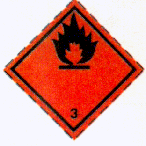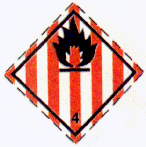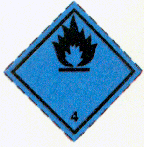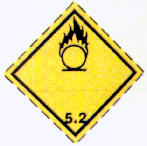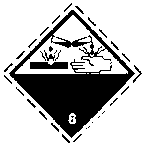Regulation 5
SCHEDULE 1CLASSIFICATION AND ASCERTAINMENT OF OTHER PARTICULARS OF DANGEROUS GOODS
PART ITABLE OF CLASSIFICATIONS AND OTHER PARTICULARS
PART IISPECIFICATION OF DANGER SIGNS
1. The danger signs to be used shall be those shown in column 6 of Part I of this Schedule for the classification of the goods shown in the corresponding entry in column 1 of that Part and the signs shall conform in form and colour to those shown in the said column 6, except that in the case of the signs for the classifications “non-flammable non-toxic gas”, “flammable gas”, “flammable liquid” and “substance which in contact with water emits flammable gas”, the symbol may be in white;
2. The words in column 7 of Part I of this Schedule may be included in the lower half of the relevant sign shown in the corresponding entry in column 6 of that Part and where included shall conform in form and colour to those shown in the said column 7, except that—
(a)in the case of the signs for the classifications “non-flammable non-toxic gas”, “flammable gas”, “flammable liquid”, “spontaneously combustible substance” and “substance which in contact with water emits flammable gas” any lettering may be in white;
(b)in place of the word “toxic”, the word “poison” may be used wherever it occurs; and
(c)in place of the word “flammable”, the word “inflammable” may be used wherever it occurs.
3. Each danger sign shall be in the form of a square set with its sides at an angle of 45° to the vertical.
4. Danger signs shall have a line of the same colour as the symbol, 5 millimetres inside the edge and running parallel to it. (The broken line which surrounds each sign as depicted in column 6 of Part I of this Schedule delineates the edge of that sign and need not be shown.)
PART IIIVISCOUS SUBSTANCES NOT REQUIRED TO BE CLASSIFIED AS FLAMMABLE LIQUIDS
For the purposes of Part I of this Schedule, substances which comply with the following conditions shall not be classified as flammable liquids, namely—
(a)the substance does not have the hazardous properties of a toxic or corrosive substance;
(b)the substance is a solution or homogeneous mixture which does not contain more than 20% nitro-cellulose;
(c)the flash point of the substance is equal to or greater than 23°C;
(d)in a suitable solvent separation test, the solvent which separates is not more than three per cent.of the volume of the substance; and
(e)the viscosity of the substance when determined at 23°C in a flow cup conforming to the International Standards Organisation Standard ISO 2431-1984 or British Standard BS 3900: Part A6-1986 and having a jet diameter of 6 mm is—
(i)in a case where the substance contains not more than 60 per cent.of a flammable liquid with a flash point of 61°C or less, not less than 40 seconds,
(ii)in any other case, not less than 60 seconds.
PART IVTABLE OF FLASH POINTS AND KINEMATIC VISCOSITY RANGES OF GOODS WHICH HAVE BEEN CLASSIFIED AS FLAMMABLE LIQUIDS IN ACCORDANCE WITH REGULATION 5 OF THESE REGULATIONS, WHICH HAVE A FLASH POINT OF LESS THAN 23°C AND CONTAIN EITHER NOT MORE THAN 5% OF TOXIC OR CORROSIVE SUBSTANCES WITH A PACKING GROUP OF I OR II, OR NOT MORE THAN 5% OF FLAMMABLE LIQUIDS WITH A PACKING GROUP OF I AND A SUBSIDIARY HAZARD OF TOXIC OR CORROSIVE
| (1) | (2) |
|---|---|
| Flash point | Kinematic viscosity γ (extrapolated at near-zero shear rate) (mm2/s at 23°C) |
| Above 17°C | 20<γ≤80 |
| Above 10°C | 80<γ≤135 |
| Above 5°C | 135<γ≤220 |
| Above −1°C | 220<γ≤300 |
| Above −5°C | 300<γ≤700 |
| −5°C and below | 700<γ |
PART VCRITERIA FOR ASCERTAINING PACKING GROUPS OF GOODS WHICH HAVE BEEN CLASSIFIED AS TOXIC SUBSTANCES IN ACCORDANCE WITH REGULATION 5 OF THESE REGULATIONS
Toxic substances shall be allocated into packing group I, II or III in accordance with the criteria given in the table below:
| (1) | (2) | (3) | (4) | (5) |
|---|---|---|---|---|
| Packing grouip | Oral toxicity LD50 (mg/kg) | Dermal toxicity of LD50 (mg/kg) | Inhalation toxicity of dust or mists LC50 (mg/m3) | Inhalation toxicity of vapours where V is the saturated vapour concentration produced by the substance at 20°C expressed by reference to LC50 (ppm) |
The above criteria are based on LC50 data relating to one hour exposure and where such information is available it should be used. However, where only LC50 data relating to 4 hour exposures is available, then: LC50 (4 hr) × 4 shall be considered equivalent to LC50 (1 hr) for dusts or mists, and LC50 (4 hr) × 2 shall be considered equivalent to LC50 (1 hr) for vapours. | ||||
| I | ≤5 | ≤40 | ≤500 | V≥10 × LC50 and LC50≤1000 |
| II | >5 to ≤50 | >40 to ≤200 | >500 to ≤2000 | V≥LC50 and LC50 ≤3000 but not placed in packing group I |
| III | solids: >50 to ≤200 liquids: >50 to ≤500 | >200 to ≤1000 | >2000 to ≤10000 | V≥0.2 × LC50 and LC50 ≤5000 but not placed in either packing group I or II |



